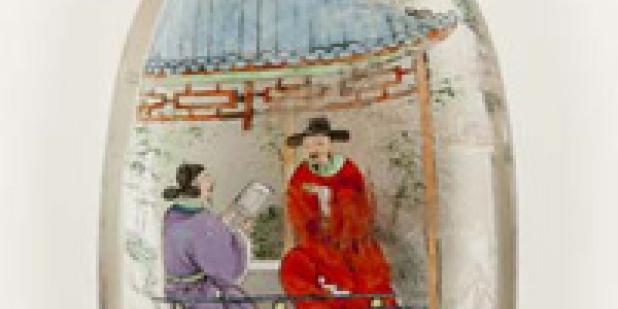Happy Lunar New Year from the USC US-China Institute!
Interior Landscapes: The Art of the Chinese Snuff Bottle
Chinese snuff bottles will be on display at the Honolulu Academy of Arts.
Where

Native to the Americas, the spread of tobacco around the world was initiated by the voyage of Christopher Columbus in 1492, when Europeans were first exposed to the plant. Among the uses of tobacco that Columbus and his crew saw was the insufflation of powdered tobacco, or “snuff,” through the nose, recorded by Ramon Pane during Columbus’ second voyage in 1493-1496. Over the course of the 16th century, snuff entered Europe, becoming popular after Jean Nicot, the French ambassador to Portugal, made a gift of snuff to Catherine de Medici, then regent of France, to treat her young son King Charles IX’s headaches.
In the 16th and 17th centuries, Europe was in the “Age of Exploration,” with extensive maritime trade routes established between Europe and Asia first by the Portuguese and Spanish, followed by the British and Dutch. Portugal’s Afonso de Albuquerque conquered Malacca on the Malaysian peninsula in 1511, Spain began its colonization of the Philippines in 1521 with the arrival of Ferdinand Magellan, and the Dutch and British both founded East India Companies in 1600, by which time the Dutch had already sent their first expedition to Southeast Asia, arriving in Banten (later called Batavia) on Java in 1596. This laid the foundations for a worldwide trade of spices from Southeast Asia, porcelains from China and Japan, and a wealth of other goods that would eventually result in European colonization throughout Asia, the impact of which was felt well into the 20th century.
Among the commodities that Europeans brought to Asia was snuff, which gained a foothold quickly due to the wide range of medicinal qualities attributed to it. Although the Europeans used snuff boxes for storage, the small ceramic medicine jarlets widely imported around Southeast Asia from China at the time were better suited to the hot, humid climate, and it seems likely that these jarlets served as the predecessors of the snuff bottles common in the 18th and 19th centuries. Over time, the form of the jarlets was modified, becoming smaller with thinner walls and a narrower mouth, protected by a stopper with an attached ivory spatula, and accessories such as snuff saucers developed. Although snuff probably entered into China, and even reached the imperial court, before the collapse of the Ming dynasty (1368-1644), the fate of snuff was intimately connected with the rise and fall of the Manchu Qing dynasty (1644-1911), growing in popularity as this dynasty reached its zenith in the 18th century, and declining with the fall of the dynasty in the early 20th century. At the same time, snuff bottles have outlasted their original purpose and remain one of the most popular souvenirs of a trip to China today.
This exhibition commemorates the annual convention of the International Chinese Snuff Bottle Society, held in Honolulu in October 2010. The staff of the Academy would like to extend special thanks to Mr. Y. F. Yang who has made their collection available for the exhibition, allowing us to display a wide range of superb snuff bottles from the 18th and 19th centuries, including a number of exceptionally rare early inside-painted bottles, to our Hawaii audience. In addition, the Academy is fortunate to have received an important collection of snuff bottles from Joanna Lau Sullivan, some of which are included in this exhibition, while others can be seen in the nearby Maurice J. Sullivan Gallery of Chinese Art (Gallery 16).—SHAWN EICHMAN, CURATOR OF ASIAN ART
This exhibition is sponsored in part by the International Chinese Snuff Bottle Society.
Featured Articles
We note the passing of many prominent individuals who played some role in U.S.-China affairs, whether in politics, economics or in helping people in one place understand the other.
Events
Ying Zhu looks at new developments for Chinese and global streaming services.
David Zweig examines China's talent recruitment efforts, particularly towards those scientists and engineers who left China for further study. U.S. universities, labs and companies have long brought in talent from China. Are such people still welcome?






